Cincinnati Art Museum
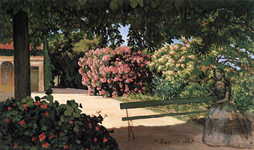
The Terrace at Méric (Oleander), Frédéric Bazille
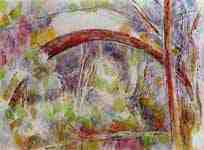
River at the bridge of the three sources, Paul Cézanne

Still life with bread and eggs, Paul Cézanne
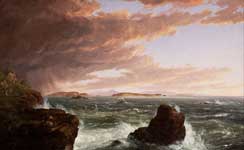
Views Across Frenchman's Bay from Mt. Desert Island, After a Squall, Thomas Cole
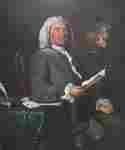
Portrait of Thomas Greene, John Singleton Copley

Hunting Camp on the Plains, Henry François Farny

Renegade Apaches, Henry François Farny
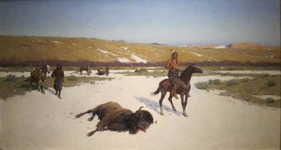
The Last of the Herd, Henry François Farny
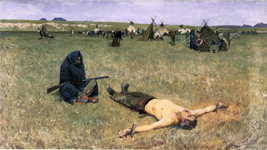
The Captive, Henry François Farny

Christ in Agony on the Cross, El Greco
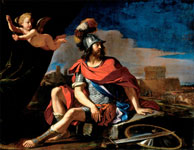
Mars with Cupid, Giovanni Francesco Guercino

Family Portrait, Frans Hals

Peasant Woman Resting, Leon-Augustin Lhermitte
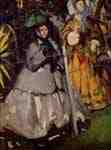
Spectators at the race, Edouard Manet

St. Christopher, Hans Memling

St. Stephen, Hans Memling

St. Thomas of Villanueva dividing his clothes among beggar boys, Bartolomé Esteban Perez Murillo

Road by the Mill, Theodore Robinson
The Cincinnati Art Museum is one of the oldest art museums in the United States. Founded in 1881, it was the first purpose-built art museum west of the Alleghenies. Its collection of over 65,000 works make it one of the most comprehensive collections in the Midwest. Museum founders debated locating the museum in either Burnet Woods, Eden Park, or downtown Cincinnati on Washington Park. Charles West, the major donor of the early museum, cast his votes in favor of Eden Park sealing its final location. The Romanesque-revival building designed by Cincinnati architect James W. McLaughlin opened in 1886. A series of additions and renovations have considerably altered the building over its 120 year history.
In 2003, a major addition, The Cincinnati Wing was added to house a permanent exhibit of art created for Cincinnati or by Cincinnati artists since 1788. The Cincinnati Wing includes fifteen new galleries covering 18,000 square feet (1,700 m2) of well-appointed space, and 400 objects. The Odoardo Fantacchiotti (it) angels are two of the largest pieces in the collection. Fantacchiotti created these angels for the main altar of St. Peter in Chains Cathedral in the late 1840s. They were among the first European sculptures to come to Cincinnati. The Cincinnati Wing also contains the work of Frank Duveneck, Rookwood Pottery, Robert Scott Duncanson Mitchell and Rammelsberg (Cincinnati's premier 19th-century furniture manufacturer) and a tall case clock by Luman Watson.
History
In the late nineteenth century, public art museums were still very much a new phenomenon, especially as far west as Cincinnati. Following the success of the 1876 Centennial Exhibition held in Philadelphia, the Women's Art Museum Association was organized in Cincinnati with the intent of bringing such an institution to the region for the benefit of all citizens. Enthusiasm for these goals grew steadily and by 1881 the Cincinnati Museum Association was incorporated. The art museum was at first temporarily housed in the south wing of Music Hall in Over-the-Rhine.[1] Just five years later, or on May 17, 1886, the Art Museum building in Eden Park was dedicated with elaborate ceremonies.[2]
Cincinnati Art Museum Interior
The Cincinnati Art Museum enjoyed the support of the community from the beginning. Generous donations from a number of prominent Cincinnatians, including Melville E. Ingalls,[3] grew the collection to number in the tens of thousands of objects, which soon necessitated the addition of the first of several Art Museum expansions.
In 1907 the Schmidlapp Wing opened, which was followed by a series of building projects. The addition of the Emery (named after Cincinnati philanthropists Thomas J. Emery and his wife Mary Emery), Hanna and French wings in the 1930s enclosed the courtyard and gave the Art Museum its current rectangular shape and provided the space in which our American, European and Asian collections are currently shown.
Renovations during the late 1940s and early 1950s divided the Great Hall into two floors and the present main entrance to the Art Museum was established. The 1965 completion of the Adams-Emery wing increased our facility resources yet further, adding space for the permanent collection, lecture halls and temporary exhibition galleries.
In 1993, a $13 million project restored the grandeur of the Art Museum's interior architecture and uncovered long-hidden architectural details. This project included the renovation of one of the Art Museum's signature spaces, the Great Hall. In addition, new gallery space was created and lighting and climate control were improved. The Art Museum's temporary exhibition space was expanded to approximately 10,000 square feet (930 m2) to accommodate major temporary exhibitions.
By the turn of the twenty-first century, the Art Museum's collection numbered over 60,000 objects and, today, is the largest in the state of Ohio. In 2003, the Cincinnati Art Museum deepened its ties with the Greater Cincinnati community by opening the popular and expansive Cincinnati Wing, the first permanent display of a city's art history in the nation. In addition, on May 17, 2003, the Art Museum eliminated its general admission fee forever, made possible by The Lois and Richard Rosenthal Foundation.[4]
Collection
The art museum has paintings by several European Masters, including: Master of San Baudelio, Jorge Ingles, Sandro Botticelli ("Judith with Head of Holofernes"), Matteo di Giovanni, Mattia Preti, Bernardo Strozzi, Frans Hals, Bartolomé Esteban Murillo ("St. Thomas of Villanueva"), Peter Paul Rubens ("Samson and Delilah") and Aert van der Neer. The collection also includes works by Jean-Baptiste-Camille Corot, Pierre-Auguste Renoir, Camille Pissarro, Claude Monet ("Rocks At Belle Isle"), and Pablo Picasso. The museum also has a large collection of paintings by American painter Frank Duveneck ("Elizabeth B. Duveneck").
Exhibitions
The Cincinnati Art Museum found it impractical to spend as much as $2.5 million a year on special exhibitions, given its declining endowment when it has unexploited holdings like circus posters and Dutch contemporary design. As a result, in 2010 the museum mounted “See America,” nine small shows that highlighted different parts of the country through the museum’s collection. Attendance at the museum has increased by 30 percent since it started emphasizing its permanent collection.[5]
Management
Admission and hours of operation
General admission to the Cincinnati Art Museum is free every day, made possible by a donation from The Richard and Lois Rosenthal Foundation. Special exhibitions are also free. Saturday's free admission is funded by The Thomas J. Emery Free Day Endowment, established by Mary Emery in 1906. Free general admission for children is made possible in part through an endowment established by Cincinnati Financial Corporation/The Cincinnati Insurance Companies. Education program fees may apply to adults and children.
The Art Museum, located at 953 Eden Park Drive in Eden Park, is open Tuesdays through Sundays, 11 a.m. to 5 p.m. Closed on Mondays. Parking fee per vehicle is $4.
Funding
By 2011, the museum's endowment was down to about $70 million from about $80 million in 2008.[5]
Controversies
In 2012, the City Council of Cincinnati had to issue an emergency ordinance to allow artist Todd Pavlisko to shoot a rifle on the grounds of the Cincinnati Art Museum as part of an exhibition titled "Crown," whereby a bullet will be fired from the ground floor's Schmidlapp Gallery into a chunk of bronze in the institution's Great Hall. The bullet, to be fired by one of the country's leading snipers, will in turn be filmed by Pavlisko using high-speed cameras and video, with the resulting documentation making up the bulk of the exhibition.[6]
References
Picturesque Cincinnati. John Shillito Company. 1883. p. 10.
Clark, S. J. (1912). Cincinnati, the Queen City, 1788-1912, Volume 2. The S. J. Clarke Publishing Company. p. 456. Retrieved 2013-05-20.
"Melville. Ingalls, Financier, is Dead". The New York Times. July 12, 1914. p. C5.
http://www.cincinnatiartmuseum.org/absolutenm/templates/ArtTempTheMuseum.aspx?articleid=31&zoneid=9
Robin Pogrebin (April 12, 2011), Money Tight, Museums Mine Their Own Collections New York Times.
Council says rifle shot OK in Cincinnati Art Museum project Cincinnati Enquirer, October 17, 2012.
----
Fine Art Prints | Greeting Cards | Phone Cases | Lifestyle | Face Masks | Men's , Women' Apparel | Home Decor | jigsaw puzzles | Notebooks | Tapestries | ...
----
Artist
A - B - C - D - E - F - G - H - I - J - K - L - M -
N - O - P - Q - R - S - T - U - V - W - X - Y - Z
Retrieved from "http://en.wikipedia.org/"
All text is available under the terms of the GNU Free Documentation License


